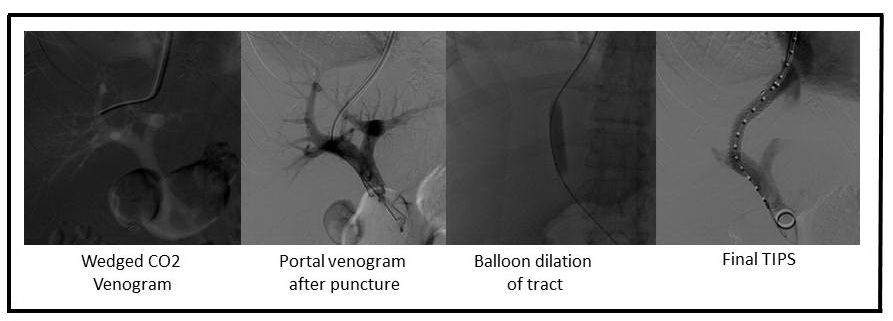[1]
Khoury T, Massarwa M, Daher S, Benson AA, Hazou W, Israeli E, Jacob H, Epstein J, Safadi R. Endoscopic Ultrasound-Guided Angiotherapy for Gastric Varices: A Single Center Experience. Hepatology communications. 2019 Feb:3(2):207-212. doi: 10.1002/hep4.1289. Epub 2018 Dec 10
[PubMed PMID: 30766958]
[2]
Lattanzi B, D'Ambrosio D, Merli M. Hepatic Encephalopathy and Sarcopenia: Two Faces of the Same Metabolic Alteration. Journal of clinical and experimental hepatology. 2019 Jan-Feb:9(1):125-130. doi: 10.1016/j.jceh.2018.04.007. Epub 2018 May 5
[PubMed PMID: 30765945]
[3]
Sonavane AD, Amarapurkar DN, Rathod KR, Punamiya SJ. Long Term Survival of Patients Undergoing TIPS in Budd-Chiari Syndrome. Journal of clinical and experimental hepatology. 2019 Jan-Feb:9(1):56-61. doi: 10.1016/j.jceh.2018.02.008. Epub 2018 Mar 1
[PubMed PMID: 30765940]
[4]
Chen SL, Hu P, Lin ZP, Zhao JB. The Effect of Puncture Sites of Portal Vein in TIPS with ePTFE-Covered Stents on Postoperative Long-Term Clinical Efficacy. Gastroenterology research and practice. 2019:2019():2935498. doi: 10.1155/2019/2935498. Epub 2019 Jan 9
[PubMed PMID: 30728835]
[5]
Darrow AW, Gaba RC, Lokken RP. Transhepatic Revision of Occluded Transjugular Intrahepatic Portosystemic Shunt Complicated by Endotipsitis. Seminars in interventional radiology. 2018 Dec:35(5):492-496. doi: 10.1055/s-0038-1676092. Epub 2019 Feb 5
[PubMed PMID: 30728666]
[6]
Valentin N, Weisberg I. The role of transjugular intrahepatic portosystemic shunt in the management of portal vein thrombosis. European journal of gastroenterology & hepatology. 2019 Mar:31(3):403-404. doi: 10.1097/MEG.0000000000001318. Epub
[PubMed PMID: 30720607]
[7]
Bertino F, Hawkins CM, Shivaram G, Gill AE, Lungren MP, Reposar A, Sze DY, Hwang GL, Koo K, Monroe E. Technical Feasibility and Clinical Effectiveness of Transjugular Intrahepatic Portosystemic Shunt Creation in Pediatric and Adolescent Patients. Journal of vascular and interventional radiology : JVIR. 2019 Feb:30(2):178-186.e5. doi: 10.1016/j.jvir.2018.10.003. Epub
[PubMed PMID: 30717948]
Level 2 (mid-level) evidence
[8]
David A, Liberge R, Meyer J, Morla O, Leaute F, Archambeaud I, Gournay J, Trewick D, Frampas E, Perret C, Douane F. Ultrasonographic guidance for portal vein access during transjugular intrahepatic portosystemic shunt (TIPS) placement. Diagnostic and interventional imaging. 2019 Jul-Aug:100(7-8):445-453. doi: 10.1016/j.diii.2019.01.004. Epub 2019 Jan 31
[PubMed PMID: 30711496]
[9]
Wong K, Ozeki K, Kwong A, Patel BN, Kwo P. The effects of a transjugular intrahepatic portosystemic shunt on the diagnosis of hepatocellular cancer. PloS one. 2018:13(12):e0208233. doi: 10.1371/journal.pone.0208233. Epub 2018 Dec 28
[PubMed PMID: 30592722]
[10]
Nardelli S, Gioia S, Ridola L, Riggio O. Radiological Intervention for Shunt Related Encephalopathy. Journal of clinical and experimental hepatology. 2018 Dec:8(4):452-459. doi: 10.1016/j.jceh.2018.04.008. Epub 2018 May 5
[PubMed PMID: 30564003]
[11]
Downing TM, Khan SN, Zvavanjanja RC, Bhatti Z, Pillai AK, Kee ST. Portal Venous Interventions: How to Recognize, Avoid, or Get Out of Trouble in Transjugular Intrahepatic Portosystemic Shunt (TIPS), Balloon Occlusion Sclerosis (ie, BRTO), and Portal Vein Embolization (PVE). Techniques in vascular and interventional radiology. 2018 Dec:21(4):267-287. doi: 10.1053/j.tvir.2018.07.009. Epub 2018 Jul 29
[PubMed PMID: 30545506]
[12]
Khan F, Mehrzad H, Tripathi D. Timing of Transjugular Intrahepatic Portosystemic Stent-shunt in Budd-Chiari Syndrome: A UK Hepatologist's Perspective. Journal of translational internal medicine. 2018 Sep:6(3):97-104. doi: 10.2478/jtim-2018-0022. Epub 2018 Oct 9
[PubMed PMID: 30425945]
Level 3 (low-level) evidence
[13]
Leng X, Zhang F, Zhang M, Guo H, Yin X, Xiao J, Wang Y, Zou X, Zhuge Y. Comparison of transjugular intrahepatic portosystemic shunt for treatment of variceal bleeding in patients with cirrhosis with or without spontaneous portosystemic shunt. European journal of gastroenterology & hepatology. 2019 Jul:31(7):853-858. doi: 10.1097/MEG.0000000000001349. Epub
[PubMed PMID: 30633039]

